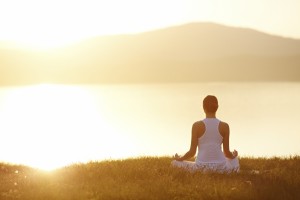Do you find it difficult to stay calm and the struggle ultimately leads to even more stress? This week’s Calmista Blog, by nutritionist and yoga teacher Charlotte Watts, discusses eight habits of calm people that can help you to find your inner harmony during the most hectic of times
I feel that I can now claim that I am a calm person – most of the time. The truth is, it doesn’t come that easily to me, but it has been my life’s work for nearly 15 years, so I do know how to bring myself back round (without too much fuss) when I wander off into old habits of taking on too much and getting irritable and intolerant.

I went to my first yoga class in 1996 because of the mind-blowing realisation that I rarely spend a single moment in the present.
To be carefree with a clear head and laid-back approach, was a burning ambition of mine back in my twenties when the reality was much different. I lived 24-7 in the great and exhausting state of anxiety, pretty much including the rare times I actually got to sleep. I went to my first yoga class in 1996 because of the mind-blowing realisation that I rarely spend a single moment in the present. There are many folks like me, who may seem to waft around calmly – my yoga students think I’m mostly on the serene side of the spectrum – but are working hard in the background to stay connected to the balance we’ve learnt to love. They don’t see me getting my daughter out of the house for the school run!

I know many yogis or meditation practitioners who may well have gone a different route if they hadn’t found this way to approaching life. If the other path of agitation and a loud and reactive mind seemed to be the only option, it stands to mind that we might want to mollify or numb with any number of addictive or medicated habits – alcohol, spending, sex, sugar, excessive exercise…..whatever our chosen negative coping pattern of choice.
So whether they have inherent or acquired calm, there are a few key traits that separate out the equanimous; the calm from the jumpy:
- THEY KNOW WHEN TO WALK AWAY
Stress, conflict and pressure all create feelings of being hemmed in, constricted and with little escape possible. We all need to know we can extricate ourselves from people or situations we find stifling to be able to get a sense of perspective and respond from a place of composure. Even just stepping to another room or going outside for a few moments can give us a new viewpoint and ability to listen and speak without self-defensiveness.
- THEY KNOW HOW TO SAY NO
Saying no without offending or needing to justify is a fine skill and extremely important in time and energy management. We can lose our cool when we take on too much and feel tired and resentful of others for asking. Setting clear boundaries that respect ourselves as much as others isn’t selfish, it’s good for all of our relationships and our stress levels.

- THEY KNOW WHAT THEY NEED
Being calm means having the space and the awareness to be able to pay attention to what your gut is telling you. If you are being ruled by a chatty head, it will want to speed things up. If you sit, and feel what’s happening neck down, most often we notice our bodies want to slow down and come back to peace. It’s nature’s way to conserve energy.
- THEY SEE HEALTH AS A KINDNESS (to themselves)
Treating our bodies as ‘things’ we need to punish, mould or force into an ideal, only serves to reinforce thoughts of unworthiness. It is not healthy when the treatment of our bodies doesn’t involve self-compassion. Eating, moving and living well for you comes back to listening to what you need and responding accordingly. This means comparing yourself to others, smiling when things go off track and knowing we’ll come back to what suits your because your body will love you for it.
- THEY KNOW WHEN TO MOVE AND WHEN TO BE STILL
Rest is a key part of movement, how else can muscle rebuild, systems reset and immunity modulate? Doing too much is a recipe for burnout and illness. Getting the balance between up and down is always the conscious feeling type of decision-making we do, when we are responding from a connected place. If you are tired and you force yourself to go for a run when your body would prefer a restorative yoga session you’re responding from the want to achieve. But knowing how to recover and rejuvenate allows us to regulate energy and find balance – that leads to more energy in the long run.

- THEY UNDERSTAND LESS CAN BE MORE
Following that theme, the very essence of calmness is being able to slow down; to just be, not to have to do, do, do all the time. The appreciation of life and small detail that comes from a peaceful vista, enhances our ability to feel subtle tones, feelings and notice inner signals to modify our words and actions as we go along. We call this ‘listening and responding’ in yoga and it is a key part of reducing speed to be in each moment.
- THEY DON’T FOLLOW THE HERD
Anxious states are more likely to surface when we feel the need to please others, to be liked or to not rock the boat. Following your heart and those rumbling gut feelings (yes you can trust them!) means you can steer a clear path with responses and decisions that feel true to your beliefs and values – very calming indeed. And people will respect you for that, not everyone will like you but that was never possible anyway…..
- THEY LIKE MIDDLE GROUND
If you are anything like I was, my younger life was fueled by a love of the highs and then suffering the troughs between to put up with them. Balance in the middle seemed boring until I had the realisation so many of us have (thanks again, yoga): that levelling these out is the way to sanity and actual contentment, as opposed to jarring up – where energy spikes steal from the time period after. Calm is the opposite of roller-coasters of emotion and energy. This equanimity comes from learning to respect and enjoy down-time as much as life’s excitements.
Read more posts by Calmista, Charlotte Watts

Like this article? Sign up to our newsletter to get more articles like this delivered straight to your inbox.





















































